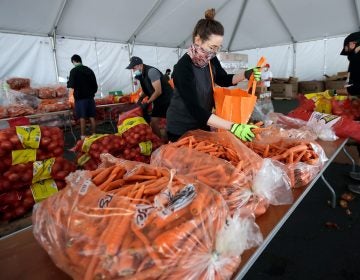Malnutrition hits the obese as well as the underfed

A variety of fried snacks and soft drinks are for sale in Mexico City's Centro Historico neighborhood. (Meghan Dhaliwal/for NPR)
Hunger once seemed like a simple problem. Around the globe, often in low-income countries, many people didn’t get enough calories.
But increasingly, hunger exists side-by-side with obesity. Within the same community, some people are overweight while others don’t have enough to eat.
And the tricky part: You can’t “fix” hunger by just feeding people empty calories. You’ve got to nourish people with healthy, nutrient-dense foods, so they don’t become obese.
A new report published in The Lancet shines a spotlight on this paradox. The dual problems of undernourishment and obesity — often referred to as the double burden of malnutrition.
For example, people can begin life not getting enough calories and become stunted — below average height for age — but by adulthood can become overweight due to an abundance of cheap calories.
Similarly, an obese teenager even in a wealthy country like the U.S. can easily grow overweight from eating junk food yet still be deficient in micronutrients that are key for optimal health.
“The new nutrition reality is about countries having not just undernutrition or just having obesity but about … the combination of both,” says Corinna Hawkes, a report author, and director of the Centre for Food Policy at City, University of London.
The report finds an estimated 2.3 billion children and adults are overweight and more than 150 million children are stunted. The problem, researchers say, is that the ideal diet includes plenty of fruits and vegetables, whole grains and beans, but much of the globe has developed a taste for snack foods full of refined carbohydrates and sugar.
“The poorest low- and middle-income countries are seeing a rapid transformation in the way people eat, drink and move at work, home, in transport and in leisure,” says report author Barry Popkin, a professor of nutrition at the University of North Carolina, Chapel Hill. “The new nutrition reality is driven by changes to the food system, which have increased availability of ultra-processed foods that are linked to increased weight gain.”
Popkin and his co-authors argue that systematic changes are needed to fix the problem: Everything from changing food production and processing to how foods are priced, labeled and marketed.
“All relevant policies and investments must be radically re-examined,” says Francesco Branca, Director of the Department of Nutrition for Health and Development at the World Health Organization.
And, given that poor diets are now linked to more deaths than smoking, there’s an urgency, researchers say.
“We can no longer characterize countries as low-income and undernourished, or high-income and only concerned with obesity. All forms of malnutrition have a common denominator: food systems that fail to provide all people with healthy, safe, affordable and sustainable diets,” Branca says.
We asked experts and thinkers in global nutrition to share initiatives and policies aimed at tackling the problem. Some are old, some old; all these efforts take on urgency given the scope of the problem.
Grow healthier foods
Focusing on the production and distribution of nutrient-dense foods is a good place to start, says Danielle Nierenberg, president and founder of Food Tank. She points to the work of the World Vegetable Center, which helps farmers in Asia and Africa grow an array of vegetables in an effort to prevent micronutrient deficiencies and malnutrition.
“One of the most interesting things they do is help provide resources for women farmers to create value-added products, like vegetable powders. These have the dual benefit of preventing food loss and waste, and providing essential nutrients throughout the year, as well as a source of income,” Nierenberg says.
She says in addition to projects like this, the group works to improve vegetable breeding practices.
“This focus on veggies will help transform diets and health but only if governments and policy makers realize their importance,” Nierenberg says.
She also points to the work of the International Center for Research in the Semi-Arid Tropics‘ (ICRISAT) Smart Food project that is promoting grain crops like millets and sorghums to improve nutrition. Both are nutrient-dense and provide a mix of fiber, protein and micro-nutrients.
“Milllets and sorghums have long been neglected and they have an image problem — they’re thought of as ‘birdseed’ or considered poor people’s foods,” Nierenberg says. “But they’re highly nutritious, they have a low glycemic index, they’re resilient to drought and disease and they’re delicious.”
Money talks
To address obesity and poor nutrition, we can’t rely on people to use willpower to make healthier choices, says Will Masters, professor in the Friedman School of Nutrition and Science Policy at Tufts University. Instead, he argues that government regulations and taxes can play a key role in shifting what we eat and drink.
He points to the U.K., where the government introduced a tax on sugary drinks that took effect in 2018. The policy was structured to give manufacturers an incentive to redo their products: When a company reduces sugar in its products below a certain threshold, they can avoid the tax.
There’s already some evidence that the policy has led to changes on store shelves. The U.K. grocery retailer Tesco reformulated all 251 of its house brand sodas to reduce sugar — and avoided the levy. “Tesco customers are now consuming on average over 20% less sugar from our soft drinks than in 2011,” a Tesco executive told The Guardian in 2016.
“It’s a clear example where taxes are a stick that leads the company to dial down the sugar in these beverages, ” Masters says.
Governments can also design food subsidy programs that encourage healthier eating among low-income beneficiaries of government food aid. The idea is that people who are low-income beneficiaries of government food aid don’t just need calories — they need nourishment. And they may need to be educated on how to get it.
Professor Hawkes, who is one of the authors of the new Lancet report, cites Egypt and Mexico as examples. In Mexico, “people who received cash [for food] also received training and education about healthy eating,” she says.
With a change in government in Mexico last year, these programs are in flux. In the U.S, the Women, Infants and Children (WIC) federal nutrition program also combines food assistance with nutrition education and support for low-income moms.
Promote breastfeeding
To prevent undernutrition early in life, there are increasing efforts to promote breastfeeding around the globe, says Jessica Fanzo, professor of global food and agricultural policy and ethics at Johns Hopkins University. The added benefit is that breastfeeding can also help protect against obesity and type 2 diabetes later in life.
“There is strong evidence suggesting that exclusively breastfeeding children has both short-term and long-term benefits to child health and nutrition,” Fanzo says.
She points to the growth of the Baby-Friendly Hospital Initiative, which was started by WHO and UNICEF back in the early 1990s, in an effort to promote breastfeeding. A hospital or clinic maternity ward can be designated “baby-friendly” when it implements a series of steps such as not accepting free or low-cost baby formulas, helping mothers start breastfeeding within a half-hour of birth, giving newborns no food or drink other than breastmilk (unless medically necessary), keeping babies in the room with their mothers to encourage breastfeeding on demand and giving no pacifiers to babies.
The program has been implemented in hospitals and clinics in many countries, and has been shown to be effective in helping women both initiate breast feeding — and stick with it. Fanzo says it’s one evidence-based way to promote health and good nutrition.
Invest in farmers
To transform the food system, governments have to help farmers, especially in low- and middle-income countries, says Ertharin Cousin, a distinguished fellow at the Chicago Council on Global Affairs and former executive director of the World Food Programme.
She says there are lots of initiatives that can work — aid to secure financing, technologies to improve storage so farmers don’t lose their harvests, access to improved seeds and fertilizer.
Cousin says there are lots of unfunded business opportunities within the food and agricultural sectors. Together with a group of partners, earlier this year she started a hybrid nutrition impact fund, Food Systems for the Future (FSF) Institute. She says the goal is to improve nutrition outcomes for underserved and low-income communities.
Get to know your veggies
Imagine growing vegetables that you never eat. That’s the reality for some farm families in the highlands of Guatemala.
“Many of these moms work in the fields tending to a marvelous variety of vegetables that are largely grown for export,” says Roger Thurow, a senior fellow at the Chicago Council on Global Affairs who focuses on food and agriculture.
There’s a big opportunity, he says, to improve nutrition by making people more comfortable using vegetables in the kitchen. He points to the Nutrition Rehabilitation Program by Primeros Pasos, a clinic in the western highlands of Guatemala that teaches families the importance of eating the nutrient-dense crops around them. The moms in the program attend regular nutrition classes, which include cooking lessons.
Within the U.S., the group Share Our Strength operates Cooking Matters in cities throughout the country. Classes are held to teach families who have very limited budgets to shop for and cook healthy meals. It’s one of a growing number of programs aimed at changing behavior by teaching people how to cook and educating them about the important health benefits of good nutrition
Thurow writes in his book, The First 1,000 Days, about other initiatives, including a home visitation program in Chicago to help support and educate moms in low-income neighborhoods about the importance of good nutrition. In his book he describes a doula — a health worker who assists a woman during pregnancy and delivery — bringing a bag of fresh produce to pregnant women when she comes to see them.
“It’s basically house-to-house combat against malnutrition,” Thurow says.
9(MDAzMzI1ODY3MDEyMzkzOTE3NjIxNDg3MQ001))




